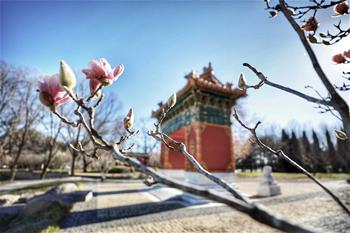XINING, Aug. 23 (Xinhua) -- The population of endangered birds has grown from 61 to 111 in a nature reserve in Sanjiangyuan in northwest China's Qinghai Province, which is home to the headwaters of the Yangtze, Yellow and Lancang rivers, over the past 30 years.
The Longbao National Nature Reserve, established in 1984, boasts five kinds of state first-class protected birds such as black-necked cranes, black storks and golden eagles, said Pasang Tsering, head of the administration station with the nature reserve.
In 2013, China put forward the establishment of a national park system. The country aims to set up a batch of national parks and form a unified management system by 2020.
Pilot projects are underway for 10 national parks, including one in Sanjiangyuan, which started trial operation in 2016 and is set to open in 2020.
"We will take the construction of Sanjiangyuan National Park as an opportunity to play a bigger role in biodiversity conservation," Pasang Tsering said.
China held the first forum on national parks Monday in Xining, capital of northwest China's Qinghai Province, which attracted more than 450 representatives of regulatory agencies, experts and scholars from home and abroad to discuss topics including the construction and management of nature reserve areas, biodiversity protection and the future of natural heritage sites.
"Through this new national park system, China has the opportunity to contribute to world biodiversity conservation," said Jonathan Jarvis, former director of the U.S. National Park Service.
China has approved the pilot plans for a spate of national parks, such as Sanjiangyuan, Shennongjia and Nanshan, with a total land area of more than 200,000 sq km.
"The construction of national parks is crucial to the more systematic and effective conservation of biodiversity," said Yang Rui, director of National Park Research Institute with Tsinghua University, "As one of the most biodiversity-rich countries in the world, China can make a revolutionary change in biodiversity conservation."
"To develop national parks is the best way to preserve biodiversity," said Tang Xiaoping, an officer with the National Forestry and Grassland Administration. He took a pilot project for Qilian Mountain National Park for example, which covers 50,200 sq km in the provinces of Qinghai and Gansu and makes major typical ecosystems and water sources included in a national park.
According to Tang, rare species in the national parks, including Siberian tigers, giant pandas and snow leopards, which can attract more funds and mobilize more social strength, have made significant contributions to biodiversity conservation in China.
"The protection of flagship species such as snow leopards can also promote the management of fragmented nature reserves," said Tang.
More and more civil forces in China have also joined in biodiversity conservation.
Green River, an environmental NGO in Sichuan, has recruited nearly 200 volunteers to protect bar-headed goose, which is believed to be the world's highest-flying fowl, in the headwater region of the Yangtze River, and conduct surveys of the birds since 2012, said Yang Xin, the group's director.
Since the conservation project was launched, the population number of the bar-headed geese has stabilized at about 3,000, said Yang.

















